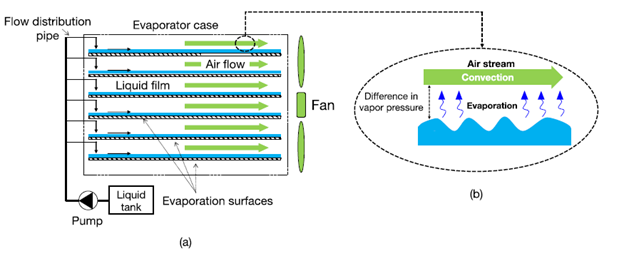Modular convection-enhanced evaporation (CEE) system for brine management
An energy efficient modular convection-enhanced evaporation (CEE) system and control algorithm for brine management

Applications
- Brine management for small and large scale desalination plants
- Volume reduction of industrial wastewater
- Onsite treatment of produced water from the oil & gas industry
- Brine mining
Key Benefits & Differentiators
- Lower energy consumption: control software updates the system’s operating settings in real-time as a function of ambient conditions to minimize energy consumption while maintaining a constant evaporation rate target
- Control algorithm and software: designed to make the convection-enhanced evaporation system a stand-alone unit; adaptable to existing and new designs of convection-enhanced evaporators; able to update its operating variables in time-variant and fluctuating weather conditions
- Custom design: modular design that can be easily customized to different sized plants and weather conditions; ideal for system expansion
- Low footprint: designed as a set of packed evaporation surfaces; liquid is released as films on multiple evaporation surfaces and forced convection is induced by a fan
Modular convection-enhanced evaporation (CEE) system and optimal control algorithm
Desalination systems provide alternative water sources, helping to address the global scarcity of freshwater. However, all desalination processes result in two fluid streams, the product stream and the byproduct stream known as the brine or concentrate. Heavily contaminated brines are also produced in several other industries, such as textile dyeing and electroplating. Brine management is subjected to strict environmental regulations that sometimes require zero liquid discharge. However, current brine disposal methods either pose significant risks to the environment (e.g. deep-well injection and land application) or involve high energy consumption and upfront costs, such as multi-effect distillation.
Researchers at the University of Minnesota have developed both a modular convection-enhanced evaporation (CEE) system for brine management and a novel control algorithm/software that optimizes the operating settings of CEE in real-time to minimize energy consumption while maintaining a constant evaporation target. The software makes CEE a stand-alone unit (or group of units) able to operate in different weather conditions in an energy-efficient status. The software and the modular system provides a flexible design that can be easily manufactured and customized for different sized operations, and has lower thermal and electric consumption, footprint area, and total costs.The proposed CEE system is composed of a set of packed hydrophilic evaporation surfaces at uniform spacing. Liquid is released along each evaporation surface forming thin film, a fan attached to the CEE unit forces air flow over the films and the difference in vapor pressure between the air and liquid induces evaporation; a heating element is usually integrated in the system to preheat the fluid. The innovative design of the CEE device enables 5 times less energy consumption than traditional solutions, reducing the overall operating costs and carbon footprint. A case study (Alamogordo, NM) showed competitive costs of less than 1 USD per cubic meter of evaporated liquid. This new system has low maintenance costs, and it is particularly relevant for brine management for decentralized desalination plants and small industries.
Phase of Development
TRL: 4-6A control algorithm and software for energy consumption minimization in time-varying weather conditions have been developed. A case study in the U.S. (Alamogordo, NM) shows promising results of less than 1 USD per cubic meter evaporated. A mathematical model and optimization software that can simulate and optimize the system have been developed. The performance of a pilot CEE system operating in outdoor conditions has been characterized for validation. Further development steps include investigating hybrid operation (combination between natural wind airflow and electric fan driven airflow) to further minimize the energy consumption and make CEE more sustainable; In addition to investigation of other flow configurations for performance and cost improvement.
Desired Partnerships
This technology is now available for:- License
- Sponsored research
- Co-development
Please contact our office to share your business’ needs and learn more.
Researchers
- Mustafa Kaddoura PhD candidate, Mechanical Engineering
- Natasha Wright, PhD Richard and Barbara Nelson Assistant Professor, Mechanical Engineering
-
expand_more library_books References (1)
- Kaddoura, Mustafa F., Matthew Chosa, Prakash Bhalekar, and Natasha C. Wright , Mathematical modeling of a modular convection-enhanced evaporation system
-
expand_more cloud_download Supporting documents (1)Product brochureModular convection-enhanced evaporation (CEE) system for brine management.pdf